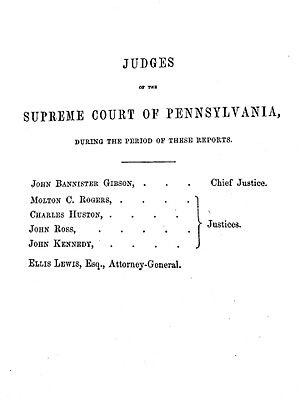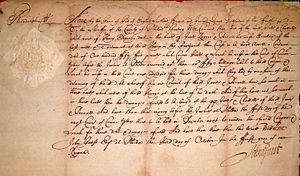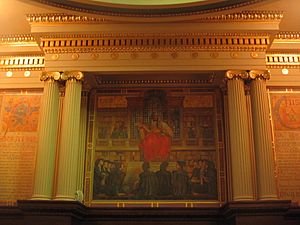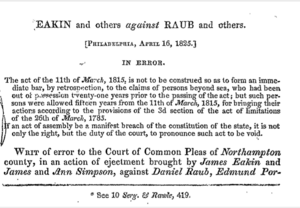Supreme Court of Pennsylvania facts for kids
Quick facts for kids Supreme Court of Pennsylvania |
|
|---|---|
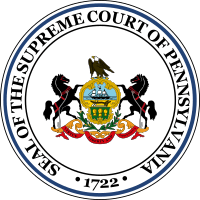 |
|
| Established | May 22, 1722 (1684 as Provincial Court) |
| Jurisdiction | Pennsylvania |
| Location |
|
| Composition method | partisan election with "Yes/No" retention election at end-of-term |
| Authorized by | Constitution of Pennsylvania |
| Appeals from | Superior Court of Pennsylvania Commonwealth Court of Pennsylvania |
| Judge term length | 10 years |
| Number of positions | 7 |
| Chief Justice | |
| Currently | Debra Todd |
| Since | October 1, 2022 |
The Supreme Court of Pennsylvania is the most important court in Pennsylvania. It is part of Pennsylvania's Unified Judicial System. This court started in 1684 as the Provincial Court. It officially became the "Supreme Court" in 1722. This happened when it became separate from the control of the colonial governor. It is the oldest appellate court in the United States. An appellate court reviews decisions made by lower courts.
The Supreme Court of Pennsylvania usually chooses which cases it will hear. This is called a discretionary docket. However, it must hear certain appeals, like those involving the death penalty. This power allows the Court to greatly influence how Pennsylvania laws are understood and used.
Contents
History of the Court
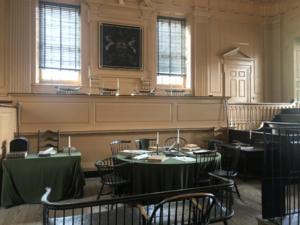
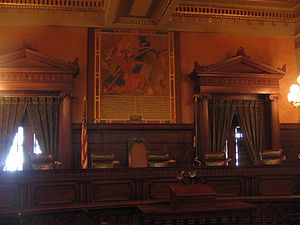
The first rules for Pennsylvania, written by William Penn, set up a Provincial Court. This court was controlled by the British governors. But the General Assembly, which made laws, wanted the government to have separate parts. They asked for a third branch of government in 1701.
In 1722, the British governor needed the Assembly to raise money. The Assembly agreed to raise taxes if they got an independent Supreme Court. Until 1776, laws and court decisions in Pennsylvania could be reviewed by the Privy Council of the United Kingdom in London.
Between 1780 and 1808, there was another court called the Pennsylvania High Court of Errors and Appeals. This was the final court for appeals. After it closed in 1808, the Supreme Court of Pennsylvania became the highest court. It has been the highest court ever since.
The Supreme Court of Pennsylvania is more than 100 years older than the United States Supreme Court. It was one of the first courts in the U.S. to say that it could declare laws unconstitutional. This means it could decide if a law made by lawmakers went against the Pennsylvania Constitution. This happened in the case Respublica v. Duquet in 1799.
How the Court Works
The court holds sessions in three cities: Philadelphia, Pittsburgh, and Harrisburg.
Justices and Their Terms
The Pennsylvania Supreme Court has seven justices. Each justice is elected for a ten-year term. People running for a justice position can be part of a political party. The justice who has served the longest on the court automatically becomes the Chief Justice.
Justices must leave the Supreme Court when they turn 75. However, they can still work part-time as "senior justices" on lower courts until they are 78.
Election and Retention
Before 2002, judges in Pennsylvania could not share their opinions on legal or political issues. But this rule changed. Now, judicial candidates can express their views. They just cannot promise how they will rule on future cases.
After a ten-year term, voters decide if a judge should stay in office. This is a "yes" or "no" vote. If the judge is retained, they serve another ten-year term. If not, the governor appoints a temporary replacement. Then, a special election is held.
Only one judge has not been retained since 2005. Justice Russell M. Nigro was not retained in 2005. Governor Rendell appointed Justice Cynthia Baldwin to replace him.
Only one Supreme Court Justice, Rolf Larsen, has been removed from office. This happened through impeachment in 1994. The State House of Representatives accused him of misconduct. The State Senate voted to remove him on one of the charges.
From 1874 until 1968, Supreme Court justices were elected for 21-year terms. This was the longest term for any elected office in the United States at that time.
Current Justices
The Supreme Court of Pennsylvania has seven members. They are elected for ten-year terms.
Meet the Current Members
| Justice | Born | Joined | Term ends | Mandatory retirement | Party affiliation | Law school |
|---|---|---|---|---|---|---|
| Debra Todd, Chief Justice | October 15, 1957 | January 7, 2008 | 2027 | 2032 | Democratic | Pittsburgh |
| Christine Donohue | December 24, 1952 | January 4, 2016 | 2026 | 2027 | Democratic | Duquesne |
| Kevin Dougherty | May 19, 1962 | January 4, 2016 | 2026 | 2037 | Democratic | Antioch |
| David Wecht | May 20, 1962 | January 4, 2016 | 2026 | 2037 | Democratic | Yale |
| Sallie Updyke Mundy | June 29, 1962 | July 21, 2016 | 2027 | 2037 | Republican | Pittsburgh |
| Kevin Brobson | November 26, 1970 | January 3, 2022 | 2031 | 2045 | Republican | Widener |
| Daniel McCaffery | July 20, 1964 | January 2, 2024 | 2033 | 2039 | Democratic | Temple |
Key Court Cases
- Eakin v. Raub (1825): The Court decided it could review state laws. It could declare them unconstitutional if they went against the state constitution. This is called judicial review.
- Commonwealth v. Mimms (1975): The Court ruled that certain charges against Harry Mimms were wrong. His case was sent back for a new trial because his Fourth Amendment rights were violated. The Supreme Court of the United States later overturned this decision in Pennsylvania v. Mimms (1977).
- League of Women Voters of Pennsylvania v. Commonwealth (2018): The Court decided that the 2011 congressional map drawn by the state's legislature was unfair. It was an illegal gerrymander. The Court ordered the congressional map to be redrawn.
- Commonwealth v. Williams (2014): The Court decided to overturn a stay of execution for Terrence "Terry" Williams. This was despite concerns about the former Chief Justice Ronald D. Castille having prosecuted Williams earlier. The Supreme Court of the United States later overturned this decision in Williams v. Pennsylvania (2016).
- Commonwealth v. Davis (2019): The Court ruled that the Fifth Amendment protects people. It means they cannot be forced to give their digital account passwords to law enforcement.
- Commonwealth v. Barr II (2021): The Court decided that police cannot search without a warrant based only on the smell of certain substances.
See Also
- State supreme court
- King's Bench jurisdiction
- Superior Court of Pennsylvania
- Commonwealth Court of Pennsylvania
- List of state and county courthouses in Pennsylvania
- Marbury v. Madison


